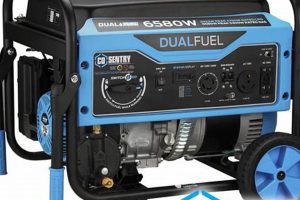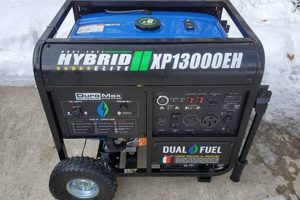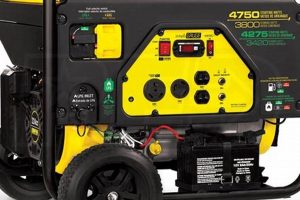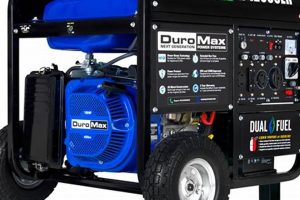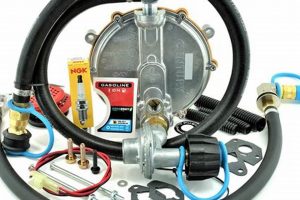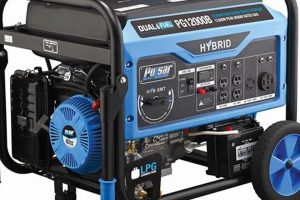Generators capable of operating on both gasoline and propane offer consumers versatility and cost-effectiveness. This adaptability allows users to select the most readily available or economical fuel source, depending on circumstances. For instance, propane can provide extended run times and cleaner emissions, while gasoline offers wider availability, particularly in emergencies.
The availability of these adaptable power sources provides significant advantages in various situations. From emergency home backup power during outages to recreational activities like camping or tailgating, the flexibility of fuel choice ensures consistent power. Historically, generators relied primarily on a single fuel source, limiting their practicality. The development of dual-fuel technology broadened their appeal and usability, making them a valuable asset for both homeowners and outdoor enthusiasts. This innovation addressed the need for a reliable power source capable of adapting to changing fuel availability and cost fluctuations.
Further exploration will cover key considerations for consumers, including power output, runtime, fuel efficiency, and important safety features. A comprehensive understanding of these factors will enable informed purchasing decisions based on individual needs and circumstances.
Tips for Selecting a Dual-Fuel Portable Generator
Choosing the right generator requires careful consideration of several factors. These tips provide guidance for navigating the selection process effectively.
Tip 1: Power Requirements Assessment: Calculate the total wattage required to power essential appliances and devices. Consider both starting wattage (initial surge) and running wattage (continuous operation). A generator’s rated wattage should comfortably exceed these calculated needs.
Tip 2: Fuel Capacity and Runtime: Evaluate expected runtimes on both gasoline and propane. Larger fuel tanks generally offer longer operation between refills. Consider typical usage scenarios and choose a generator with sufficient fuel capacity.
Tip 3: Portability Considerations: Assess the generator’s weight and dimensions, especially if frequent transportation is anticipated. Features like wheels and handles can enhance portability.
Tip 4: Noise Level Evaluation: Generators produce varying noise levels. Consider the intended operating environment and choose a model with an acceptable decibel rating, especially for residential or noise-sensitive areas.
Tip 5: Safety Feature Inspection: Look for essential safety features such as automatic shutdown for low oil levels, overload protection, and carbon monoxide detectors.
Tip 6: Budgetary Considerations: Establish a budget before exploring available options. Prices vary based on wattage, features, and brand. Balancing features and affordability is crucial for optimal value.
Tip 7: Warranty and Support: Review warranty terms and available customer support. A reputable manufacturer’s warranty and reliable customer support contribute significantly to long-term peace of mind.
Careful consideration of these tips will empower consumers to select a generator that aligns with individual needs and budget constraints. A well-chosen generator provides reliable power during outages or in off-grid situations.
By understanding the nuances of generator selection and employing these tips, individuals can invest in a valuable resource that delivers reliable performance for years to come.
1. Fuel Flexibility
Fuel flexibility stands as a defining characteristic of dual-fuel portable generators, directly impacting their usability and value. This adaptability, derived from the capacity to utilize both gasoline and propane, offers significant advantages in various scenarios. Consider a natural disaster scenario disrupting gasoline supply lines; a dual-fuel generator allows seamless transition to propane, ensuring continued power for essential needs. Conversely, during regular operation, the cost-effectiveness of propane might be preferred over gasoline, offering potential long-term savings.
This inherent flexibility empowers users to adapt to fluctuating fuel prices and availability. The ability to switch between fuel sources provides a critical safeguard against unforeseen circumstances. Imagine a camping trip where gasoline reserves dwindle; the option to utilize readily available propane ensures continued power for essential appliances and devices. This practical adaptability enhances the reliability and overall utility of these generators, positioning them as versatile power solutions.
In summary, fuel flexibility provides a crucial advantage in a world of dynamic energy markets and potential supply disruptions. This adaptability ensures consistent power availability, regardless of fuel source accessibility or price fluctuations. Dual-fuel portable generators represent a robust solution for individuals seeking reliable power across diverse situations, from emergency preparedness to recreational activities.
2. Power Output
Power output, measured in watts, represents a critical specification for dual-fuel portable generators. This metric directly dictates the generator’s capacity to power various devices and appliances. Understanding power output requirements is essential for informed purchasing decisions, ensuring the selected generator aligns with individual needs.
- Starting Wattage vs. Running Wattage
Starting wattage, also known as surge wattage, refers to the initial power surge required to start electric motors. Running wattage, conversely, represents the power required for continuous operation. For instance, a refrigerator might require a starting wattage of 1500 watts and a running wattage of 700 watts. Generators must accommodate both starting and running wattage demands for effective operation of connected devices.
- Wattage Requirements of Common Appliances
Different appliances and devices exhibit varying wattage requirements. A small LED light bulb may require only a few watts, while a large air conditioner could demand several thousand watts. Accurately assessing the combined wattage needs of intended devices ensures adequate generator capacity.
- Overload Protection
Exceeding a generator’s rated wattage can lead to overload and potential damage. Modern generators often incorporate overload protection mechanisms to prevent such occurrences. Understanding power output limitations and adhering to them safeguards the generator and connected devices.
- Matching Power Output to Needs
Selecting a generator with appropriate power output is crucial for effective operation. Consider both short-term and long-term power requirements. For example, powering essential household appliances during a power outage may require a higher power output than running small electronics during a camping trip.
Careful consideration of power output ensures the selected generator aligns with specific needs, preventing potential issues and maximizing utility. Matching wattage capacity to anticipated loads ensures reliable performance and prolonged generator lifespan. Understanding the nuances of starting wattage, running wattage, and overload protection empowers consumers to make informed decisions, ensuring the chosen generator meets specific power demands.
3. Portability
Portability represents a defining characteristic of these generators, significantly influencing their practical applications. The ability to easily transport these units expands their utility beyond stationary home backup power. Consider disaster relief efforts where access to affected areas might be limited; portable generators provide a crucial power source for essential operations. Similarly, in recreational contexts such as camping or tailgating, portability allows convenient access to power for various devices and appliances.
Several factors contribute to a generator’s portability. Physical dimensions and weight directly impact ease of transport. Integrated features like wheels and handles further enhance mobility. The size and weight should align with anticipated transportation methods. For instance, a compact, lightweight unit might be easily carried in a vehicle’s trunk, while a larger unit might require a trailer for transport. Consider the terrain and accessibility of intended operating locations when evaluating portability.
The practical significance of portability extends beyond mere convenience. In emergency situations, rapid deployment of power resources can be critical. The ability to quickly transport a generator to the affected area facilitates timely restoration of essential services. Furthermore, portability allows for adaptable power solutions in diverse environments, from remote construction sites to outdoor events. Understanding the portability aspects of these generators empowers consumers to select units aligning with their specific needs and intended applications.
4. Runtime Capacity
Runtime capacity represents a critical factor influencing the practicality and overall value of dual-fuel portable generators. This metric, typically measured in hours, dictates the duration a generator can operate continuously on a given fuel tank. Understanding runtime capacity is essential for ensuring the selected generator aligns with specific power needs and anticipated usage scenarios.
- Fuel Tank Size and Fuel Type
Fuel tank size directly impacts runtime capacity. Larger tanks generally provide longer runtimes. Fuel type also plays a significant role. Propane often yields longer runtimes compared to gasoline for the same tank volume. The choice between propane and gasoline operation allows users to optimize runtime based on fuel availability and cost.
- Load and Power Consumption
The load placed on the generator influences runtime. Higher power consumption reduces runtime, while lower power consumption extends it. Accurately assessing anticipated power demands helps determine the required runtime capacity. For instance, powering essential appliances during a power outage requires a greater runtime capacity than running small electronics during a camping trip.
- Efficiency and Fuel Consumption Rate
Generator efficiency directly impacts fuel consumption and runtime. More efficient generators consume less fuel per kilowatt-hour produced, leading to extended runtimes. Manufacturers often provide fuel consumption rates, allowing consumers to estimate runtime based on tank size and anticipated load.
- Practical Implications for Various Applications
Runtime capacity considerations vary depending on the intended application. Emergency backup power during extended outages requires substantial runtime capacity. Recreational use, such as camping or tailgating, might require shorter runtimes. Understanding the intended use case informs runtime capacity requirements.
Careful evaluation of runtime capacity ensures the selected generator meets specific power duration needs. Balancing fuel tank size, load requirements, and fuel efficiency leads to optimal runtime performance. Understanding the interplay of these factors empowers consumers to make informed decisions, selecting a generator that provides reliable power for the required duration.
5. Cost-Effectiveness
Cost-effectiveness represents a crucial consideration when evaluating dual-fuel portable generators. Analyzing both initial purchase price and long-term operational costs provides a comprehensive understanding of overall value. Factors such as fuel efficiency, maintenance requirements, and potential lifespan contribute significantly to long-term cost-effectiveness.
- Initial Investment
The initial purchase price varies based on power output, features, and brand reputation. While a higher initial investment might provide greater power capacity or advanced features, balancing upfront costs with actual power needs is essential for optimal value.
- Fuel Efficiency and Consumption
Fuel efficiency plays a significant role in long-term operational costs. Generators with higher fuel efficiency consume less fuel for the same power output, leading to potential cost savings over time. The ability to utilize both gasoline and propane allows users to optimize fuel costs based on current market prices.
- Maintenance Requirements and Costs
Regular maintenance is essential for optimal generator performance and longevity. Factors such as oil changes, air filter replacements, and spark plug maintenance contribute to ongoing costs. Understanding maintenance requirements and associated expenses contributes to a comprehensive cost assessment.
- Lifespan and Durability
A generator’s lifespan significantly impacts long-term cost-effectiveness. Durable, well-maintained generators offer extended service life, minimizing the need for premature replacements. Investing in a reliable, durable generator contributes to overall value over time.
Evaluating these factors provides a comprehensive understanding of a generator’s cost-effectiveness. Balancing initial investment with long-term operational expenses, including fuel costs, maintenance, and potential lifespan, enables informed purchasing decisions aligned with both power requirements and budgetary constraints. Considering these elements ensures a cost-effective power solution matching individual needs and delivering long-term value.
Frequently Asked Questions
This section addresses common inquiries regarding dual-fuel portable generators, providing concise and informative responses to facilitate informed decision-making.
Question 1: What are the primary advantages of a dual-fuel generator over a gasoline-only model?
The key advantage lies in fuel flexibility. Dual-fuel generators operate on both gasoline and propane, offering options during fuel shortages or price fluctuations. Propane also burns cleaner, extending engine life and reducing emissions.
Question 2: How is the wattage requirement determined for a specific application?
Calculate the combined running wattage of all intended devices. Add the highest starting wattage of any single device to this total. The generator’s rated wattage should exceed this combined value.
Question 3: What safety precautions are essential when operating a portable generator?
Operate generators outdoors in well-ventilated areas, away from flammable materials. Never refuel a hot generator. Install carbon monoxide detectors in nearby occupied spaces.
Question 4: How does altitude affect generator performance?
Higher altitudes reduce air density, impacting engine performance and power output. Consult the manufacturer’s guidelines for altitude adjustments and derating factors.
Question 5: What maintenance procedures are recommended for optimal generator operation?
Regular maintenance includes oil changes, air filter replacements, and spark plug inspections. Consult the owner’s manual for specific maintenance intervals and procedures.
Question 6: What considerations are relevant regarding generator noise levels?
Generators produce varying noise levels. Consider the proximity to neighbors and local noise ordinances. Some models offer quieter operation than others.
Careful consideration of these frequently asked questions provides a comprehensive understanding of key aspects related to dual-fuel portable generators. This knowledge empowers consumers to make informed decisions based on individual needs and circumstances.
For further information or specific inquiries, consulting manufacturer specifications and authorized dealers is recommended. This ensures access to accurate and up-to-date information relevant to individual generator models.
Dual Fuel Portable Generators for Sale
Careful evaluation of available options ensures acquisition of a generator aligning with individual needs. Factors such as power output, runtime capacity, fuel efficiency, portability, and safety features contribute significantly to informed purchasing decisions. Balancing these considerations empowers consumers to select a reliable power solution for various applications, from emergency preparedness to recreational activities. Understanding the nuances of dual-fuel technology optimizes generator utilization and maximizes long-term value.
Investment in a dual-fuel portable generator represents a commitment to power reliability and resilience. These versatile power sources provide critical support during unforeseen outages and expand access to power in off-grid environments. As power demands evolve and energy landscapes shift, adaptable power solutions become increasingly essential. Thorough research and informed decision-making empower consumers to harness the full potential of dual-fuel technology, ensuring access to reliable power when and where it is needed most.

